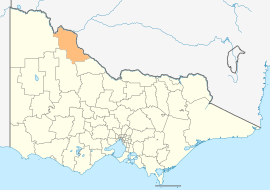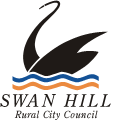| Rural City of Swan Hill Victoria | |||||||||||||||
|---|---|---|---|---|---|---|---|---|---|---|---|---|---|---|---|
 Location in Victoria | |||||||||||||||
| Population | 21,403 (2021)[1] | ||||||||||||||
| • Density | 3.5001/km2 (9.0652/sq mi) | ||||||||||||||
| Established | 1995 | ||||||||||||||
| Gazetted | 20 January 1995[2] | ||||||||||||||
| Area | 6,115 km2 (2,361.0 sq mi)[3] | ||||||||||||||
| Mayor | Les McPhee | ||||||||||||||
| Council seat | Swan Hill | ||||||||||||||
| Region | Loddon Mallee | ||||||||||||||
| State electorate(s) | |||||||||||||||
| Federal division(s) | Mallee | ||||||||||||||
 | |||||||||||||||
| Website | Rural City of Swan Hill | ||||||||||||||
| |||||||||||||||
The Rural City of Swan Hill is a local government area in Victoria, Australia, located in the north-western part of the state. It covers an area of 6,115 square kilometres (2,361 sq mi) and, in August 2021, had a population of 21,403.[3] It includes the towns of Swan Hill, Lake Boga, Manangatang, Nyah, Nyah West, Piangil, Robinvale, Ultima and Woorinen South. It was formed in 1995 from the amalgamation of the City of Swan Hill, Shire of Swan Hill and part of the Shire of Kerang.[2]
The Rural City is governed and administered by the Swan Hill Rural City Council; its seat of local government and administrative centre is located at the council headquarters in Swan Hill, it also has a service centre located in Robinvale. The Rural City is named after the main urban settlement lying in the south-east of the LGA, that is Swan Hill, which is also the LGA's most populous urban centre with a population of 10,431.[4]
- ^ Australian Bureau of Statistics (28 June 2022). "2021 Community Profiles: Swan Hill (Local Government Area)". 2021 Census of Population and Housing. Retrieved 8 May 2023.
- ^ a b Victoria Government Gazette – Online Archive (1837–1997). "S4 of 1995: Order estg (Part 14) the Rural City of Swan Hill". State Library of Victoria. State Government of Victoria (published 20 January 1995). p. 5. Retrieved 10 January 2014.
- ^ a b "3218.0 – Regional Population Growth, Australia, 2017–18: Population Estimates by Local Government Area (ASGS 2018), 2017 to 2018". Australian Bureau of Statistics. Australian Bureau of Statistics. 27 March 2019. Retrieved 25 October 2019. Estimated resident population, 30 June 2018.
- ^ Census QuickStats (2011). "Swan Hill (SS) – SSC21287". Australian Bureau of Statistics. Government of Australia. Retrieved 10 January 2014.